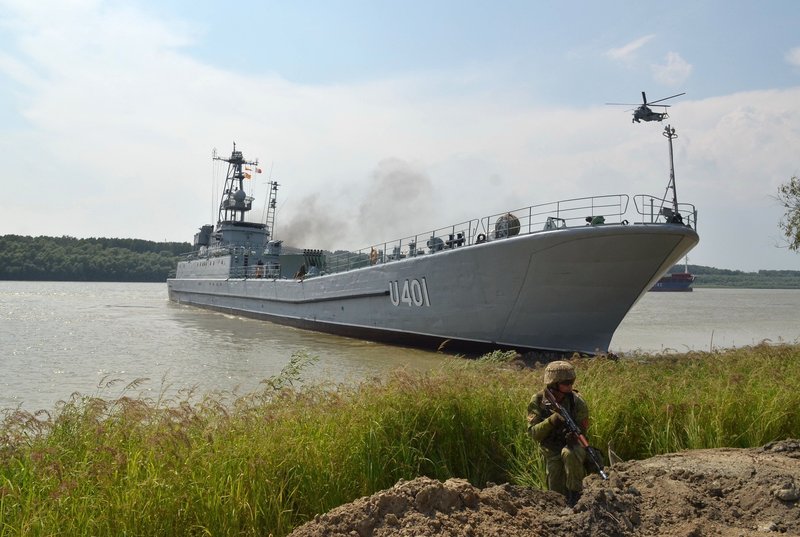Tipping the balance – can UK aid make a decisive difference for Ukraine’s Marine Corps?
The Ukrainian Marine Corps has been fighting a decisive battle along the Dnipro, in the southern region of Kherson, yet very little has been written about it. Who are they, what are they fighting for along the river and how are UK forces supporting them?
Here is a relatively little-known fact: the Ukrainians have a marine corps... Continues below
Newsletter Sponsor:

Above: UK-supplied training (and eventually watercraft) will provide a much-needed boost for Ukrainian forces operating around the Dnipro river. (Photo: UK MoD/Crown Copyright)
There is precious little information about these forces available in open sources. The corps appears to comprise four Marine Brigades (35th, 36th, 37th and 38th) as well as a 7th Anti-Aircraft Division, a 32nd Rocket Artillery Regiment, a 140th Reconnaissance Battalion and a 406th Artillery Brigade.
Even less is known about how many personnel are serving within these units. It is possible that this is because numbers are constantly fluctuating due to a high number of casualties.
As for the Ukrainian Marine Corps’ missions, until last summer there was almost no information available at all. This could partly be explained by the fact that they were involved in covert operations, or it may simply be that, in the midst of all the forces involved in the fighting over the past two years, it was difficult to distinguish who represented what.

Schiebel – leading the unmanned evolution
The silence was broken over the past few months as the four marine brigades were deployed along the Mokri Yaly valley. These brigades’ mission is to regain territories at the mouth of the Dnipro in an attempt to blockade Russia’s supply routes into Crimea.
So far, the task has proven extremely difficult. Over the course of several months, the Ukrainians have successfully regained only a sliver of land in the village of Krynky, while the human cost has been significant.
Furthermore, a recent media report from the front line outlines clearly the lack of capabilities at these forces’ disposal, not just to fight along a river but also to evacuate their wounded and dead.
Ukraine has only one amphibious ship, the 50-plus years old Yuri Olefirenko, which despite Russian claims to have sunk it appears to be currently operating further down the river – off Ochakiv, practically in the Black Sea. This capability would be critical in disembarking much-needed heavy weaponry and vehicles.
The outcome of the latest meeting of the international Ukraine Defense Contact Group (UDCG), which took place on 11 December, might finally provide some hope to these frontline troops. The UDCG is a group of 50 nations meeting several times a year to discuss what capabilities they will deliver to support the war effort.
Other articles in this newsletter:
It’s all politics – tracking long-term trends in naval procurement
Best defence? Confronting the complexities of naval C-UAS
It was announced that the UK will lead a new Maritime Capability Coalition, alongside Norway, to deliver additional capabilities necessary to strengthen Ukraine’s ability to operate at sea. This will also include river patrol craft to defend coastal and inland waterways.
Additional details concerning the types of craft to be delivered were requested during UK Parliamentary debates on 19 December, but thus far no further information has been provided.
These craft would go a long way in supporting the Ukrainian marines in Krynky and elsewhere around the river mouth. They are also in line with the training the Royal Marines and British Army Commandos have been providing to the Ukrainian marines.
This past August, the UK MoD announced that over 900 Ukrainian marines were returning home after a six-month training programme. This included learning to conduct beach raids using inflatable boats. According to the MoD press release it also included ‘training to use Next Generation Light Anti-Tank Weapons (NLAW) and Stinger anti-aircraft missiles, use of mortars and drones for reconnaissance, and explosive demolition of obstacles such as Dragon’s Teeth anti-vehicle fortifications’.

Above: Ukraine’s sole amphibious assault ship, the 1971-vintage Yuri Olefirenko, is believed to be operating close to Ochakiv in the Dnipro estuary, despite Russia's claims to have sunk it. (Photo: Ukrainian MoD)
At a rate of 900 recruits per training course, and considering the significant losses the marines are reportedly suffering in Krynky, these efforts appear slow and limited. Yet in the grand scheme of things, six months to train individuals from very different backgrounds – including civilians with no prior military experience – is pretty efficient.
The question that remains now is: how will these recruits actually fare under pressure and under fire? But every little helps, right?
Don't want to miss out on future Decisive Edge content? Make sure you are signed up to our email newsletters.











